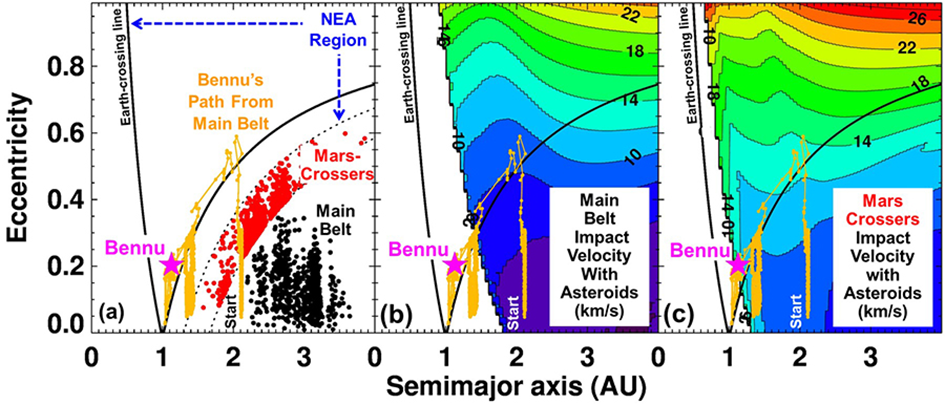Background
Near-Earth asteroids (NEAs) are fragments of the original building blocks that formed the planets. Numerous scientific and planetary defense issues can be addressed by studying them. Their accessibility, combined with the SmallSat revolution, has made them prime targets for upcoming NASA, JAXA, and ESA missions. While key mission goals are to understand the nature and history of their targets by interpreting craters, surface features, etc., this is difficult to do in practice because NEA orbits change as they interact with the planets. Specifically:
The impact flux on NEAs, which has yet to be characterized, depends on the body’s orbital history; as they evolve to different orbits, they can be hit by different populations.
NEAs are affected by impact-related crater erasure mechanisms like seismic shaking whose nature and timing depends on each body’s past impact flux and orbital history.
Some NEAs like Bennu act like “rock comets” and undergo dramatic particle ejection events. Proposed mechanisms to explain them, like the impact of small comet particles and/or the thermal cracking of rocks, depend strongly on the body’s proximity to the Sun.
Approach
We are attempting to solve these coupled problems by constructing the first comprehensive model of how dynamics, collisions, and thermal rock fracturing affect mission-target NEAs. Here we will merge several codes into an integrated model called NEA-EVOL. It will accurately account for the collisional and dynamical evolution of mission target NEAs by including the following components:
A model of how NEAs dynamically escape the main asteroid belt and evolve within the inner solar system.
New algorithms that can track impacts on NEAs from both the main asteroid belt and the planet-crossing asteroid populations.
A crater evolution code with new algorithms that can account for complex issues like crater erasure.
Results from an established NASA code that can model how meteoroid impacts of different sizes affect NEAs.
Results from an established code that can track how rocks on NEAs break in response to thermal fatigue near the Sun.
The use of a dynamical model with 2-5 will allow us, for the first time, to simulate the full end-to-end evolution of NEA mission targets.
Accomplishments
We have succeeded in creating a model of how NEAs dynamically escape the main asteroid belt and evolve within the inner solar system and have merged the dynamical evolution, impact flux, and cratering rate for NEAs using algorithms that employ the look-up tables. The next steps are to complete algorithms that can account for crater erasure via impact-induced seismic shaking and ejecta in-fill (though our first attempts at this have been interesting). At that point, we can test our model against constraints from recent missions (e.g., OSIRIS-REx’s mission to Bennu or Hayabusa2’s mission to Ryugu).

Figure 1: (a) One possible dynamical pathway for the asteroid Bennu. It starts in an inner main belt resonance and moves to current orbit (purple star). Each gold dot is 0.01 Myr. Portions of main belt and Mars-crossing (MC) populations are shown for reference. (b) Impact velocities for main belt asteroids hitting test bodies with inclination of = 5 deg. Bennu is hit until it reaches semimajor axis < 1.5 AU. (c) Same as (b), except we use Mars-crossers (MCs). MCs are 6 times the size of the near-Earth asteroid (NEA) population and can hit Bennu today!
